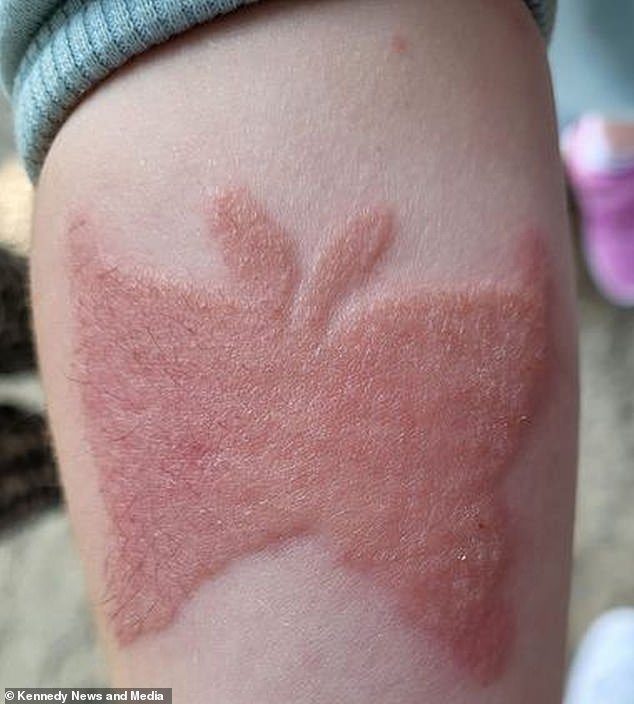n
A mother-of-two fears her seven-year-old daughter will be ‘scarred for life’ with a butterfly print on her arm following a reaction to a henna tattoo while on holiday.
Kirsty Newton, 37, had daughter Matilda Newton get the 3cm temporary tattoo on her right forearm last month while staying at an all-inclusive Turkish hotel.
Despite initially looking good, the black henna tattoo turned red and itchy after they returned home to Pudsey, West Yorkshire, resulting in two pharmacy visits.
Matilda was later rushed to hospital after the skin around the tattoo started bleeding, with doctors confirming she had suffered an allergic reaction to a chemical in the henna.
She is now urging others to be careful when giving their children henna tattoos and to ensure they have a skin test first.
Kirsty Newton, 37, had daughter Matilda Newton (pictured) get the 3cm temporary tattoo on her right forearm last month while staying at an all-inclusive Turkish hotel

Despite initially looking good, the black henna tattoo (skin pictured after tattoo) became red and itchy after they returned home to Pudsey, West Yorkshire, resulting in two pharmacy visits.

Matilda (pictured with her family in Turkey) was later rushed to hospital after the skin around the tattoo started bleeding. The doctors confirmed that she had had an allergic reaction to a chemical in the henna.
When the family of four returned to Britain, Matilda’s butterfly print began to cause a burning sensation on her skin.
The family made a few pharmacy visits in an attempt to control the reaction themselves.
But Mrs Newton rushed Matilda to Leeds General Infirmary when her skin began to crack and bleed.
Doctors there confirmed that Matilda had an allergic reaction to the black henna.
The paste is used to paint patterns on the skin and is available abroad and at some shops, stalls and festivals in Britain.
She was prescribed anti-allergy tablets, steroids and antibiotic creams to help heal her scorched skin.
Before receiving the medication, Matilda was sick and had a rash on her stomach, which doctors said could be related to the allergic reaction.
Ms Newton believes the burn was caused by paraphenylenediamine (PPD) – a chemical commonly found in black henna and dark hair dyes.
Although PPD can be legally used in hair dyes, levels are strictly controlled. But black experts warn that black henna often exceeds these amounts and produces a darker color.

Ms Newton (pictured) is now urging others to be careful if they get their children henna tattoos and make sure they have a skin test first

She fears the allergic reaction will leave an outline of the butterfly shape on Matilda’s (pictured) arm for life
She fears that the allergic reaction will leave an outline of the butterfly shape on her arm for life.
Mrs Newton said: ‘It concerns me that it is a very visible spot on her arm.
‘We weren’t told it was black henna, the tattoo stand was just advertising henna tattoos.
‘The doctor said that abroad they put more pigment in their dyes because their laws are not the same as in Britain.
“The hospital said it was an allergic reaction to the black henna used and that she can no longer use hair dye as she grows older.”
To raise awareness about the dangers of black henna, Mrs Newton posted photos of Matilda’s butterfly burn on social media.
She claims the hotel did not offer a skin test before painting on the black henna outline.
Mrs Newton said: ‘Be careful if you give your children henna tattoos.
‘People need to know what happened and make sure they get skin tests done if they have a tattoo before getting one.
‘Matilda should have had a skin test done earlier, but it was not offered.’
